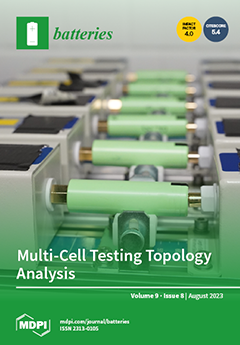Increasing demand to store intermittent renewable electricity from, e.g., photovoltaic and wind energy, has led to much research and development in large-scale stationary energy storage, for example, ZEBRA batteries (Na-NiCl
2 solid electrolyte batteries). Replacing Ni with abundant and low-cost Zn makes the
[...] Read more.
Increasing demand to store intermittent renewable electricity from, e.g., photovoltaic and wind energy, has led to much research and development in large-scale stationary energy storage, for example, ZEBRA batteries (Na-NiCl
2 solid electrolyte batteries). Replacing Ni with abundant and low-cost Zn makes the ZEBRA battery more cost-effective. However, few studies were performed on this next-generation ZEBRA (Na-ZnCl
2) battery system, particularly on its AlCl
3-NaCl-ZnCl
2 secondary electrolyte. Its properties such as phase diagrams and vapor pressures are vital for the cell design and optimization. In our previous work, a simulation-assisted method for molten salt electrolyte selection has shown its successful application in development of molten salt batteries. The same method is used here to in-depth study the AlCl
3-NaCl-ZnCl
2 salt electrolyte in terms of its phase diagrams and vapor pressures via FactSage
TM and thermo-analytical techniques (Differential Scanning Calorimetry (DSC) and OptiMelt
TM), and their effects on battery performance such as operation safety and charging/discharging reaction mechanism. The DSC and OptiMelt results show that the experimental data such as melting temperatures and phase changes agree well with the simulated phase diagrams. Moreover, the FactSage
TM simulation shows that the salt vapor pressure increases significantly with increasing temperature and molar fraction of AlCl
3. The obtained phase diagrams and vapor pressures will be used in the secondary electrolyte selection, cell design and battery operation.
Full article





